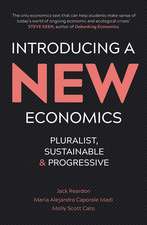Forecasting in the Presence of Structural Breaks and Model Uncertainty: Frontiers of Economics and Globalization
Autor David E. Rapach, Mark E. Wohar, Hamid Beladi, Kwan Choien Limba Engleză Hardback – 28 feb 2008
Each chapter includes detailed empirical applications that demonstrate the usefulness (and limitations) of different methods for generating forecasts when structural breaks and model uncertainty are of significant concern. The authors describe in detail their methods and their results, and the data and programs are made available on a web site devoted to the book. The volume addresses forecasting variables from both Macroeconomics and Finance, and considers many different methods of dealing with model instability and model uncertainty when forming forecasts.
* Part of the Frontiers in Economics and Globaliaztion series
* Authors are leading experts in the topics they survey and extend
* Supported by a website detailing the data and programs used
Preț: 1331.46 lei
Preț vechi: 1729.17 lei
-23% Nou
Puncte Express: 1997
Preț estimativ în valută:
254.86€ • 276.92$ • 214.22£
254.86€ • 276.92$ • 214.22£
Carte tipărită la comandă
Livrare economică 21 aprilie-05 mai
Preluare comenzi: 021 569.72.76
Specificații
ISBN-13: 9780444529428
ISBN-10: 044452942X
Pagini: 700
Dimensiuni: 152 x 229 x 1041 mm
Greutate: 0.82 kg
Editura: Emerald Publishing
Seria Frontiers of Economics and Globalization
ISBN-10: 044452942X
Pagini: 700
Dimensiuni: 152 x 229 x 1041 mm
Greutate: 0.82 kg
Editura: Emerald Publishing
Seria Frontiers of Economics and Globalization
Public țintă
Graduate students, researchers and practitioners interested in economic forecasting.Cuprins
1. Forecasting Annual U.K. Inflation using an Econometric Model over 1875-1991
2. Forecasting U.K. Inflation: The Roles of Structural Breaks and Time Disaggregation
3. Forecasting with Small Macroeconomic VARs in the Presence of Instabilities
4. Forecasting Macroeconomic Variables Using Diffusion Indexes in Short Samples with Structural Change
5. Predictive Inference Under Model Misspecification with an Application to Assessing the Marginal Predictive Content of Money for Output
6. Forecasting Persistent Data with Possible Structural Breaks: Old School and New School Lessons Using OECD Unemployment Rates
7. What Can We Learn From Comprehensive Data Revisions for Forecasting Inflation? Some U.S. Evidence
8. Estimating and Forecasting GARCH Models in the Presence of Structural Breaks and Regime Switches
9. A Source of Long Memory in Volatility
10. Forecasting Stock Return Volatility in the Presence of Structural Breaks
11. Financial Time Series and Volatility Prediction using NoVaS Transformations
12. Modeling Foreign Exchange Rates with Jumps
13. Bagging Binary and Quantile Predictors for Time Series: Further Issues
14. Forecasting Interest Rates: An Application of the Stochastic Unit Root and Stochastic Cointegration Frameworks
15. Bayesian Model Averaging in the Presence of Structural Breaks
16. The Economic and Statistical Value of Forecast Combinations Under Regime Switching: An Application to Predictable U.S. Returns
2. Forecasting U.K. Inflation: The Roles of Structural Breaks and Time Disaggregation
3. Forecasting with Small Macroeconomic VARs in the Presence of Instabilities
4. Forecasting Macroeconomic Variables Using Diffusion Indexes in Short Samples with Structural Change
5. Predictive Inference Under Model Misspecification with an Application to Assessing the Marginal Predictive Content of Money for Output
6. Forecasting Persistent Data with Possible Structural Breaks: Old School and New School Lessons Using OECD Unemployment Rates
7. What Can We Learn From Comprehensive Data Revisions for Forecasting Inflation? Some U.S. Evidence
8. Estimating and Forecasting GARCH Models in the Presence of Structural Breaks and Regime Switches
9. A Source of Long Memory in Volatility
10. Forecasting Stock Return Volatility in the Presence of Structural Breaks
11. Financial Time Series and Volatility Prediction using NoVaS Transformations
12. Modeling Foreign Exchange Rates with Jumps
13. Bagging Binary and Quantile Predictors for Time Series: Further Issues
14. Forecasting Interest Rates: An Application of the Stochastic Unit Root and Stochastic Cointegration Frameworks
15. Bayesian Model Averaging in the Presence of Structural Breaks
16. The Economic and Statistical Value of Forecast Combinations Under Regime Switching: An Application to Predictable U.S. Returns



























